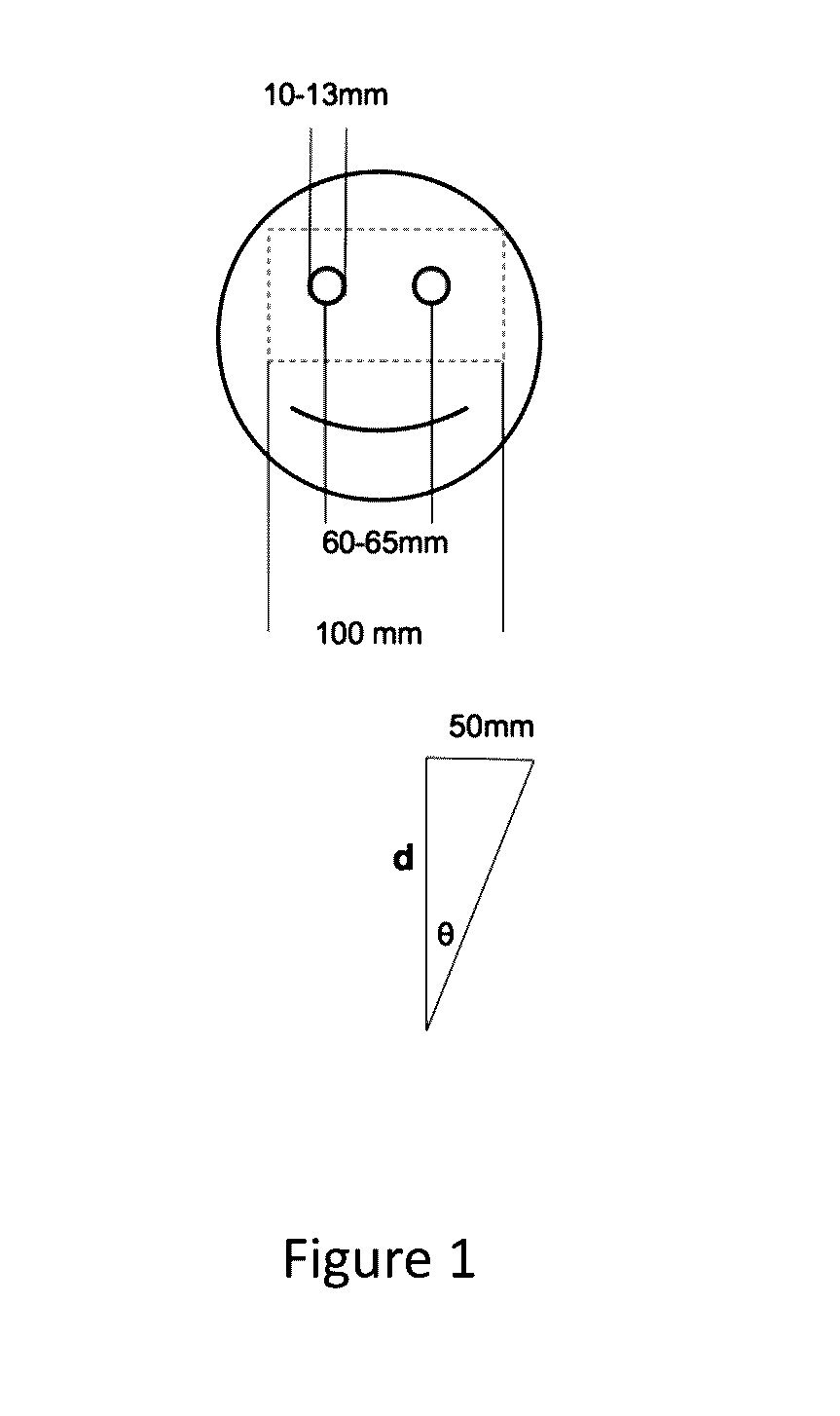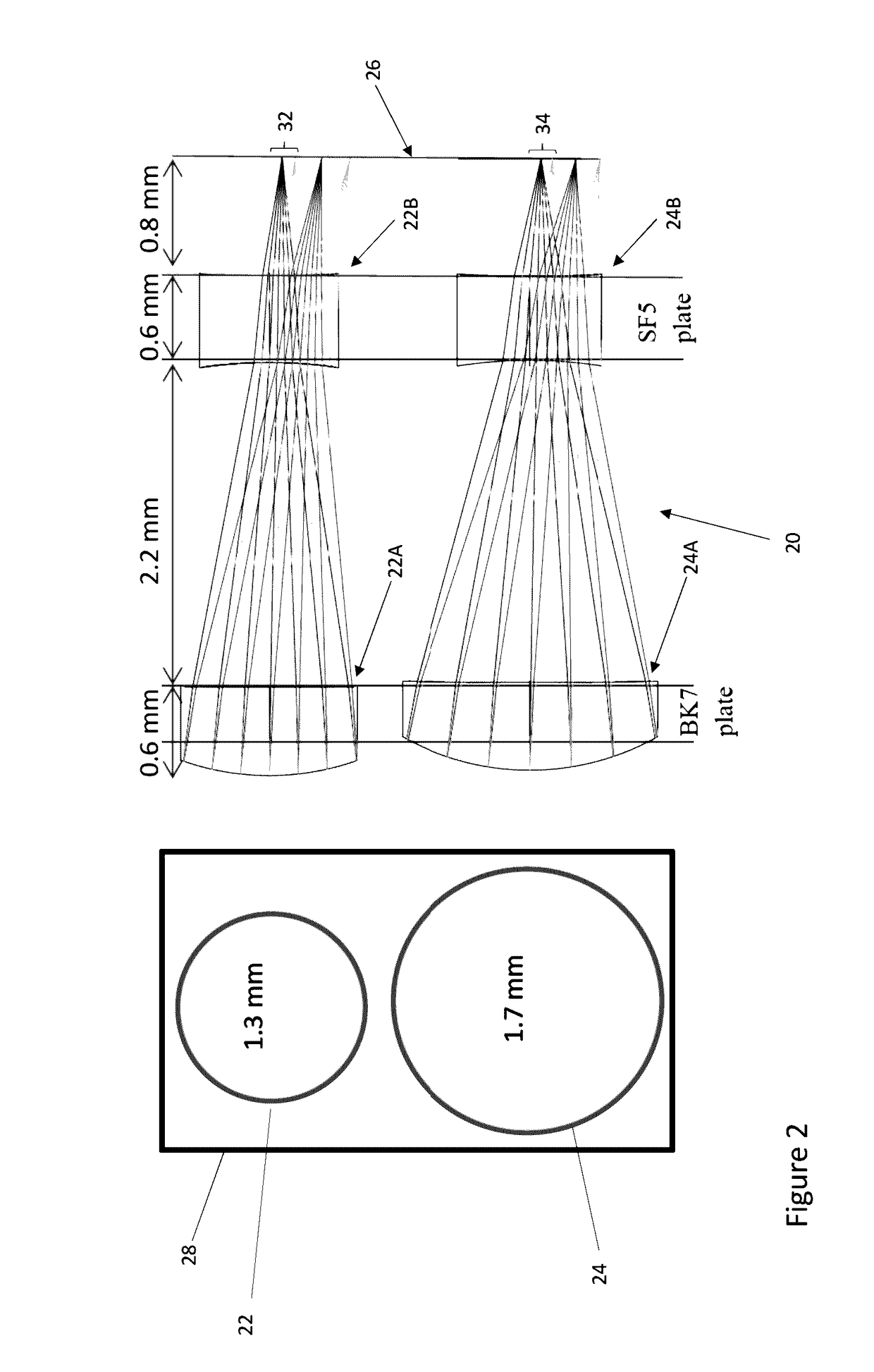Image acquisition system
a technology of image acquisition and image acquisition, applied in the field of image acquisition system, can solve the problems of affecting the quality of images, so as to achieve the effect of minimizing aberration
- Summary
- Abstract
- Description
- Claims
- Application Information
AI Technical Summary
Benefits of technology
Problems solved by technology
Method used
Image
Examples
first embodiment
[0030]Referring to FIG. 2, in a first embodiment, the optical system 20 comprises two nearly identical air-spaced lens doublets 22, 24, which are optimised for two different distances covering the overall range 180-350 mm between the eye and the camera. The doublets 22, 24 shown in front view in FIG. 2, each comprise a front optical element 22A, 24A and a rear optical element 22B, 24B. The front optical elements 22A, 24A can each be formed on the same substrate using a wafer level optic (WLO) process such as described below in more detail. Similarly, the rear optical elements 24A, 24B can be formed on the same substrate using a WLO process such as described below in more detail. Typically, a WLO process produces a large array of optical elements on a common substrate and the substrate can then be diced into plates, the outline 28 of one of which is shown in FIG. 2, comprising the optical elements for the lenses of a cluster. Each plate incorporating the front optical elements and re...
second embodiment
[0054]Turning now to FIG. 5 shows a cluster 50 of three lenses 52, 54, 56 each with respective aperture diameters arranged in an irregular grid according to the invention. The following exemplary parameters could be employed for the cluster 50 of FIG. 5:
[0055]Near distance camera (52): F1.8, f=1.7 mm, d=0.95 mm, focus 177 mm (DoF 133-265 mm) Mid-distance camera (54): F1.8, f=3.0 mm, d=1.7 mm, focus 316 mm (DoF 265-390 mm) Far-distance camera (56): F1.8, f=4.0 mm, d=2.2 mm focus 450 mm (DoF 390-530 mm)
[0056]In this example, the three camera cluster of fixed focus cameras covers all focus distances from 133 to 530 mm. As the focal lengths of each of the cameras differ, this cluster of lenses might not be as readily fabricated as those of the other embodiments described herein.
third embodiment
[0057]In a third embodiment, FIG. 6, a cluster 60 comprises 4 elements, a first 62 arranged to have a central object focus distance of, say, 18 cm, the second 64 a central focus distance of 24 cm, the third 66, a central focus distance of 32 cm and the fourth 68, a central focus distance of 42 cm. In this embodiment, the usable focus depth is least for the closest focused camera 62, say 6 cm increasing to 8 cm, 10 cm and 12 cm for each of the lenses 64 to 68. Thus the first camera can span a range from 15-21 cm, the second from 20-28 cm, the third from 27-37 cm and the fourth from 36-48 cm. Within these ranges the iris regions will be in sufficiently sharp focus for high quality acquisition by the image acquisition system.
[0058]Again, the field of view of each camera 62 to 68 is different and is determined in this exemplary embodiment for the 10 cm width across the eye region. Thus, for the first camera 62 it will have a FoV, determined by the 18 cm main focus of 31 degrees; for the...
PUM
 Login to View More
Login to View More Abstract
Description
Claims
Application Information
 Login to View More
Login to View More - R&D
- Intellectual Property
- Life Sciences
- Materials
- Tech Scout
- Unparalleled Data Quality
- Higher Quality Content
- 60% Fewer Hallucinations
Browse by: Latest US Patents, China's latest patents, Technical Efficacy Thesaurus, Application Domain, Technology Topic, Popular Technical Reports.
© 2025 PatSnap. All rights reserved.Legal|Privacy policy|Modern Slavery Act Transparency Statement|Sitemap|About US| Contact US: help@patsnap.com



